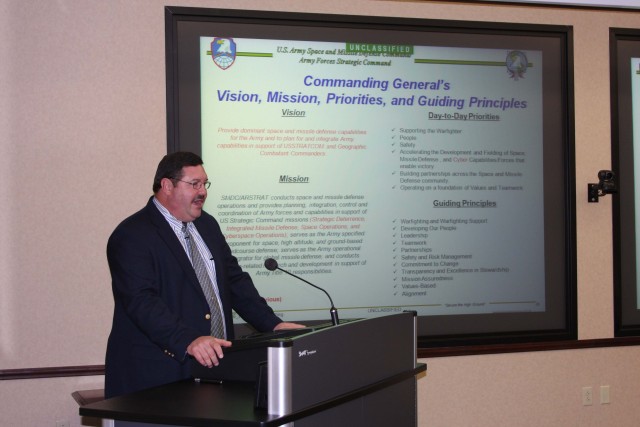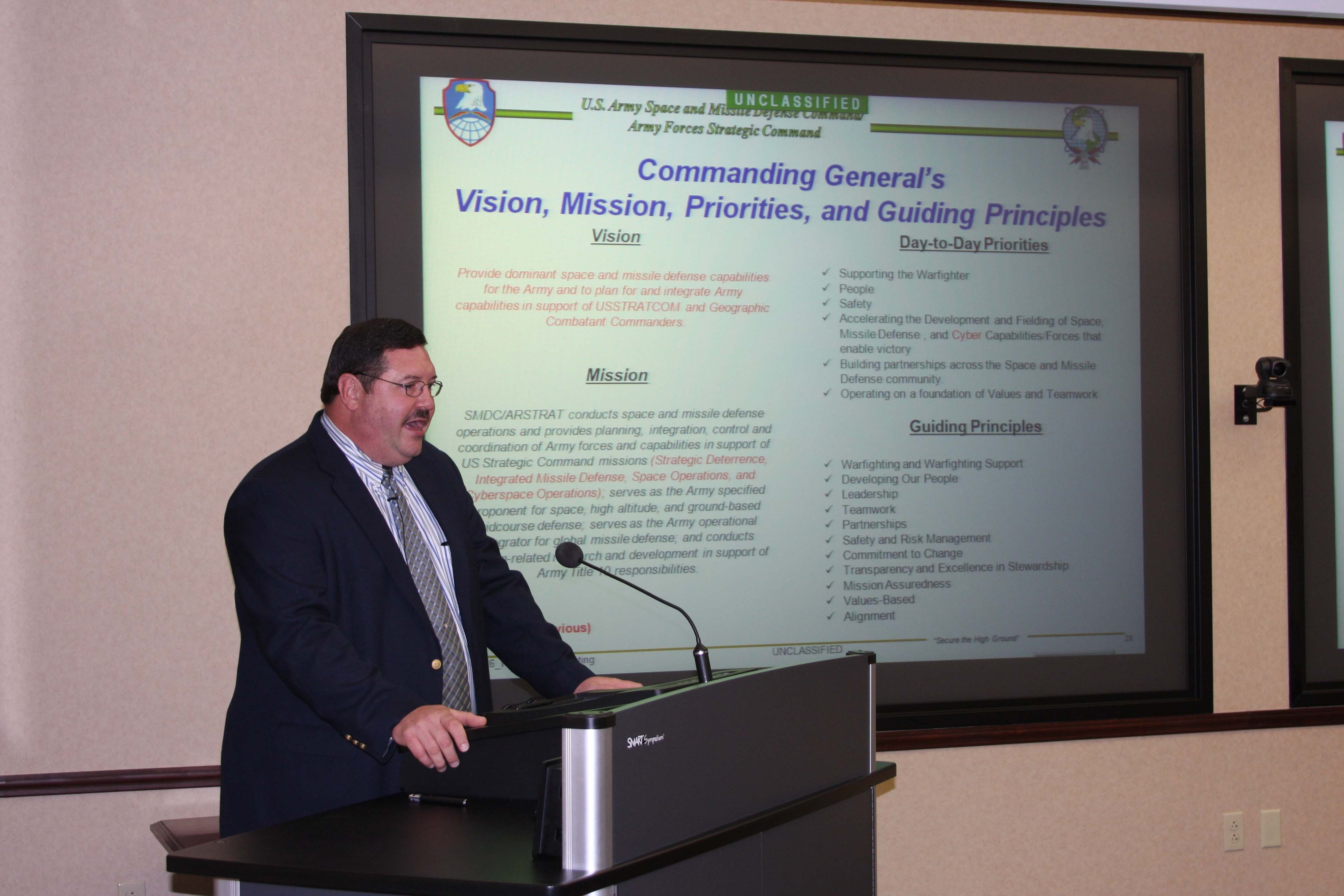REDSTONE ARSENAL, Ala. - Citing a multitude of good news stories, Dr. Rodney Robertson, director, Technical Center, U.S. Army Space and Missile Defense Command/Army Forces Strategic Command, addressed employees at a Tech Center Town Hall meeting here Aug. 26.
The meeting covered a comprehensive agenda and one of the highlights that Robertson focused on was the Concepts Analysis Lab.
"The mission of the Concepts Analysis Lab is really to develop and evaluate new technical concepts," Robertson said. "We have been able to support this mission by recruiting, training and mentoring students and young professionals to develop a cadre of technically competent personnel."
Robertson said students here and around the state have many avenues open to them for entry into the government workforce. He said these programs include Cooperative Education, Student Temporary Employment Program, DoD Science, Mathematics and Research for Transformation Scholarship for Service, Students Working at the Army in Parallel, and a program hosting U.S. Military Academy Academic Individual Advanced Development cadets.
"Students Working at the Army in Parallel students are a lot like co-op employees, but SWAP students are hired through a contract with the University of Alabama-Huntsville," Robertson said. "The UAH Research Center hires the SWAP students and sends them here. They are usually science and engineering students, are U.S. citizens and hold a secret level security clearance."
Robertson also outlined a number of other successes to include the Long Endurance Multi-Intelligence Vehicle, SMDC-One and the Central Test and Evaluation Investment Program.
The Long Endurance Multi-Intelligence Vehicle is a state-of-the-art hybrid airship that will provide persistent time-on-station for additional intelligence surveillance and reconnaissance to the theater commander. LEMV will add ISR capability to meet the growing needs of the combatant commanders.
Another success Robertson reported is the upcoming launch of the first of eight SMDC-ONE nanosatellites. The first of these small, loaf-of-bread-sized satellites is scheduled to launch later this year with the remaining nanosatellites to launch next year, said Robertson.
In addition to the cost-savings realized with the nano-satellite program, Robertson also noted a program funded by the Central Test and Evaluation Investment Program.
"We've got funding through CTEIP to build a 20,000 pound mobile launcher. That's a pretty significant launcher to be moved from one test range to another," Robertson said. "With this launcher, you aren't restrained from operational tests as you are with a fixed-launch site and its mobility will enable this program to end up being a cost-savings device and a highly mobile arena for testing."
Robertson also mentioned three additional programs--the Nuclear Arms Control Treaty program, GATR and WeaponWatch--as examples of good news stories for the command.
The Nuclear Arms Control Treaty program has also been in the forefront of the Tech Center successes by participating in the recent successful calibration test to calibrate international monitoring system sensors. Using a controlled 100-ton explosion at Israeli Sayarim Military Range, the purpose of the test was to improve infrasound Intelligent Munitions System monitoring capabilities and to characterize the Middle East region infrasound response. Preliminary results indicate that signals were measured as far away as North Africa and Germany. Initial analysis indicates test objectives were met.
Robertson also mentioned the small business success of GATR, which provided direct battlefield applications in Afghanistan and was used in the aftermath of Hurricane Katrina in New Orleans.
"GATR is a highly mobile ground satellite that can be packed into two hand-held suitcases and checked as commercial luggage on an airline," Robertson said. "It provides mobile satellite applications which are imperative on the battlefield. During the days following Hurricane Katrina, GATR was deployed and provided the lacking internet capabilities after the disaster," he said.
Robertson described another application, WeaponWatch, which is a device that has been deployed in operation Iraqi Freedom and Operation Enduring Freedom.
"WeaponWatch was first developed as an infrared system for space applications," Robertson said. "It's a battlefield application for Soldiers that can be mounted on HMMWVs or towers. WeaponWatch can detect the location of small arms and mortar fire faster than it takes to hear the sound of the weapon as it is fired."
While many battlefield successes have been launched from the Technical Center, Robertson also honored the milestones and accomplishments of his employees during the town hall meeting.
Awards for 20 years of service were presented to Hudson Harris, Hazel Hyde and Noel Paschal, and 25-year service awards were presented to Dr. Sherry Mahafza, Kaye Blankenship, Steven Eacret, Marty Sargent and Teena McGee.
In addition to the time in service awards, Robertson presented Dr. Robert McMillan a patent award for his recent patent, "Coherent Radar and Ladar Polarimeter."
Robertson closed the town hall with a slide reminding his staff of the commanding general's Vision, Mission, Priorities, and Guiding Principles.
"The CG's priorities include supporting the Warfighter, safety of our personnel, and he is very interested in developing people," Robertson noted. "He has told us to make sure we have the funds for training and development set aside, and he stresses teamwork. Most importantly, the CG always talks about treating people with dignity and respect, so keep that on your mind," Robertson concluded.


Social Sharing